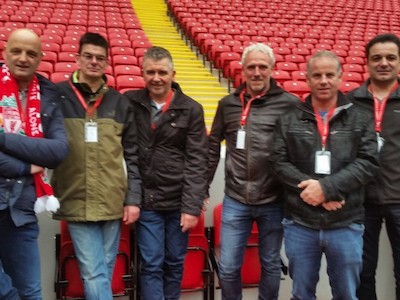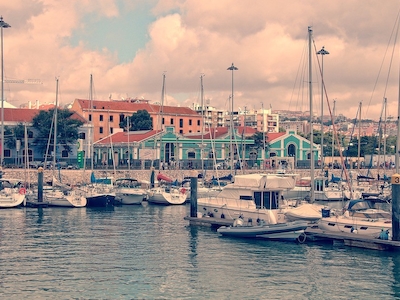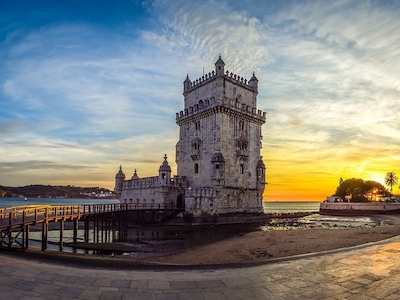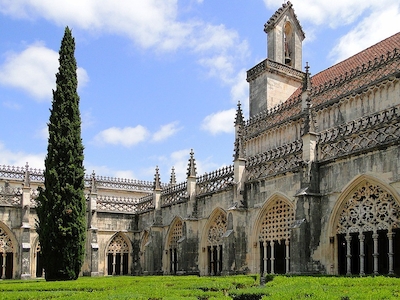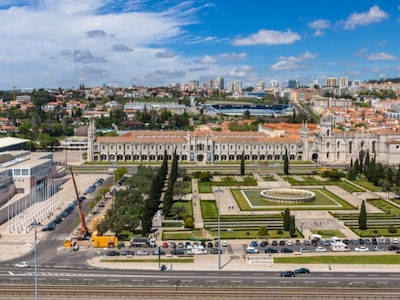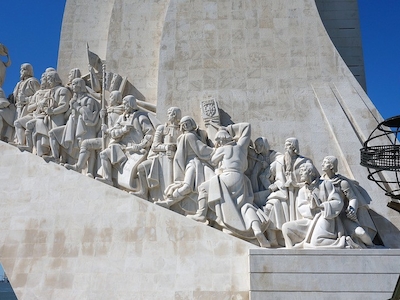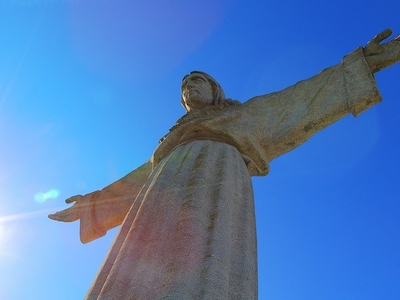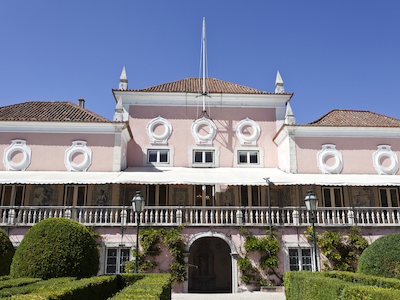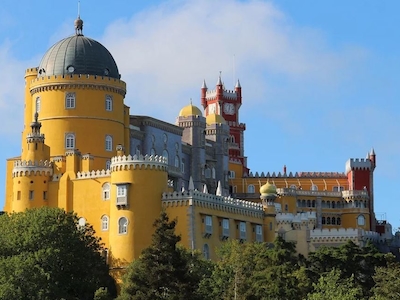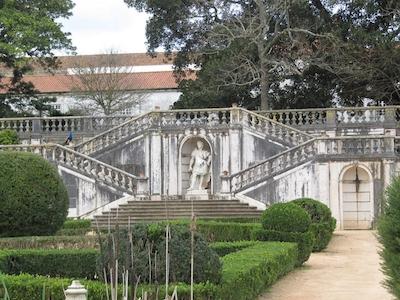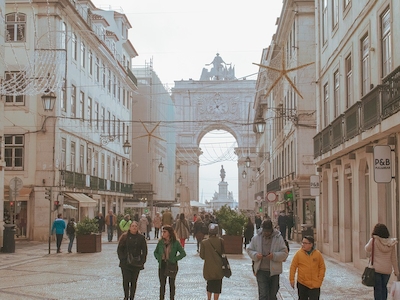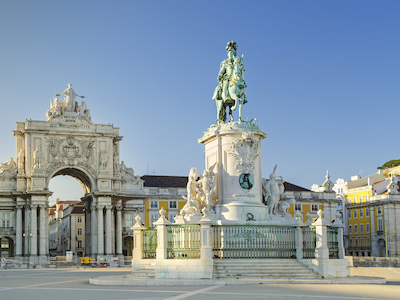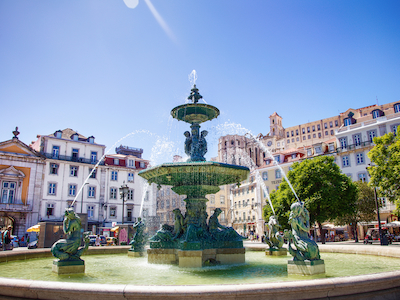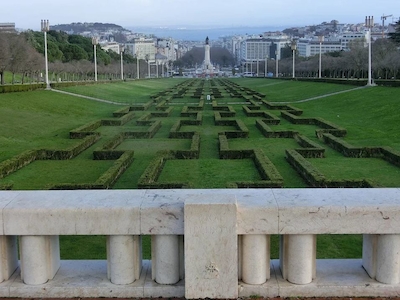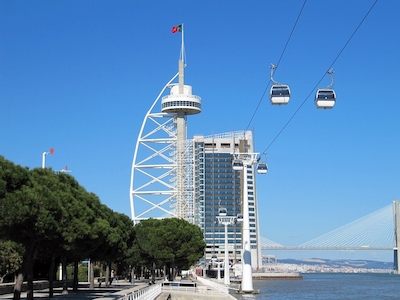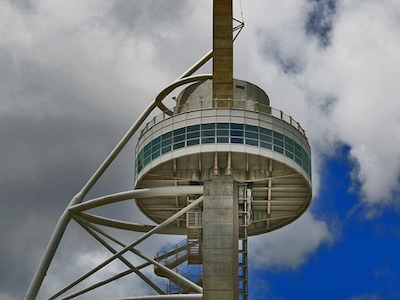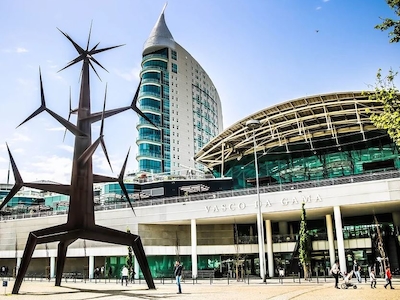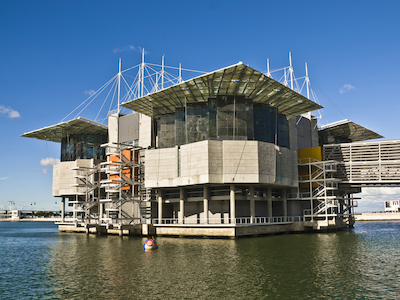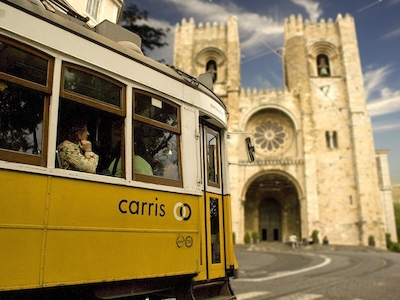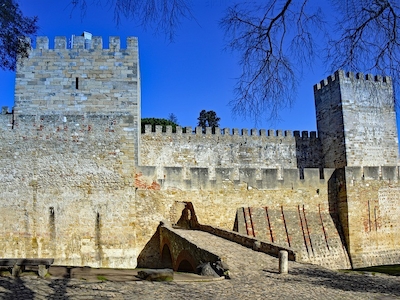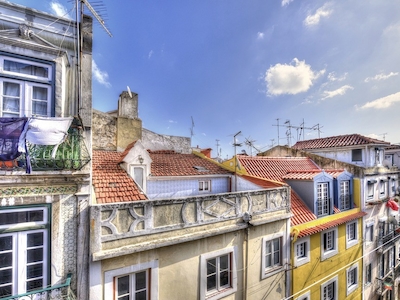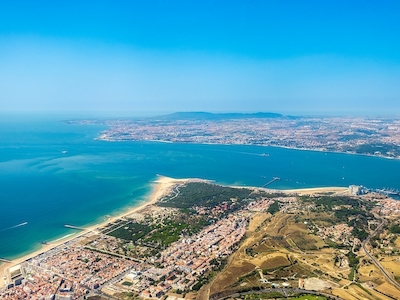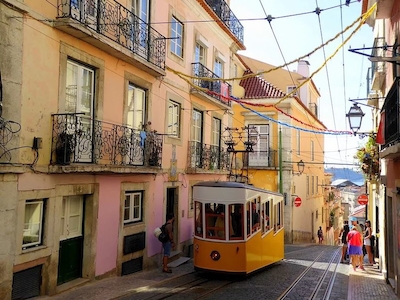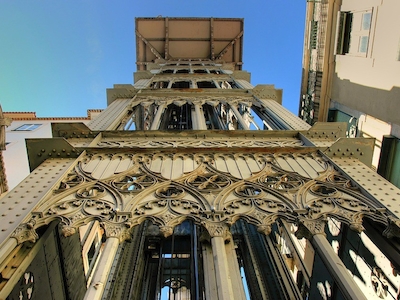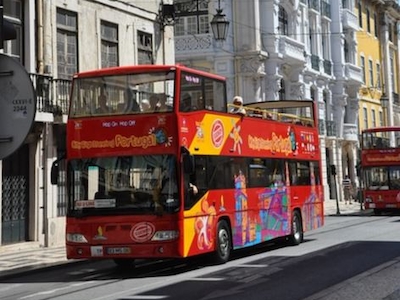A football trip to the beautiful capital city of Portugal: Lisbon
Lisbon is the beautiful capital city of Portugal, located at the shoreline of the Tagus. The city is also the biggest city of Portugal with almost 3 million inhabitants. Besides the conviviality of the city, you could also enjoy the beautiful beaches in Portugal. Streets are located at different heights in Lisbon because of the mountainous landscape of the city. This does give the city a nice touch. The historical city contains many narrow streets, with many colourful houses and buildings. Take the old-fashioned little trams into account and you’ll be able to envision a beautiful, picturesque scene!
The two big football clubs of Lisbon are SL Benfica and Sporting Lisbon. Both clubs have been active in the highest competition of Portugal since the start of the competition; the Primeira Liga.
Football trip to Lisbon
Besides visiting a great football match in Lisbon, the city is also the perfect destination for a city trip. The city belongs, without a doubt, to the most interesting cities of Europe. Lisbon’s history is full of art and culture. The most popular tourist spots are the Belém Tower and the Hieronymites Monastery; both of these buildings are on the World Heritage list of UNESCO.
When going on a football trip to Lisbon, you should realize that there are many nice things to do and visit in the city. Prolong your football trip with a couple days and combine your weekend with a city trip; you’ll kill two birds with one stone this way! Number 1 Football Travel has made a convenient overview for you which lists all the sights and spots in Lisbon you simply have to visit during your football trip. Have fun!
Belém
Belém is an important district of Lisbon, which is a great symbol of the Golden Age of Portugal. The district is located at the estuary of the Tagus, and you can visit many sights here, like museums and beautiful buildings that omit wealth and power. You’ll reach Belém by train or tram in 7 minutes from the centre of Lisbon. Tram 15 leaves from Praça do Comércio and you can board the train at Cais do Sodré to the station of Belém. When travelling by tram, it’ll take a bit longer to arrive at Belém but the view is truly stunning. The Hop-on and Hop-off buses also stop in Belém. The fort Torre de Belém, the famous Hieronymite convent and the ‘Monument of Discoveries’ are all located within a walking distance from Belém’s station.
You’ll notice that Pastéis de Belém can be found everywhere – in every little café and every bakery – in Belém. You’ll even see bowls filled with these cream pastries in hotels. The pastries were invented at Confeitaria de Belém. The recipe is a secret, obviously, so the pastries you can buy elsewhere are imitations of the Pasteis de Belém.
Torre de Belém
The Torre de Belém is a defence mechanism which is located at the shoreline of the Tagus. The building was erected at the start of the sixteenth century to commemorate Vasco de Gama's discovery travels; this was an era in which great discoveries were made and it symbolized Portugal’s power. Just like the Hieronymites Monastery - which is also located in Belém - this Tower is on the World Heritage List of UNESCO, too. The outside of the Tower is truly beautiful. You’ll see openwork balconies and watchtowers in Moorish and Gothic style, all around. There’s always a queue in front of the Tower, especially in summer. You can buy skip-the-line tickets before visiting the Tower; this is highly recommended.
Mosteiro dos Jerónimos
This beautiful Hieronymites Monastery can be found in the Belém district, and it’s on the World Heritage list of UNESCO. It’s one of the most extraordinary sights of Lisbon. The monastery was built to honour Vasco da Gama’s accomplished Voyage of Discovery. You’ll find his grave in the stunning monastery together with the graves of poets Luís de Camões and Fernando Pessoa. The monastery is adjacent to a grand square which contains a yard, and a fountain is located in the middle of the square. Thousands of tourists visit the Hieronymites Monastery daily, so there are long queues. You can order tickets online before visiting the monastery, which will give you access to skip the line.
Museu Nacional de Arqueologia
After visiting the Mosteiro dos Jerónimos, you can walk straight to this archeological museum! The museum was established around 1893 and you can see Portuguese archaeological artefacts here. The museum contains remnants of buildings and other special collections that’ll tell you more about the history of Portugal.
Padrão dos Descobrimentos
The Monument to the Discoveries, the Padrão dos Descobrimentos, is located adjacent to the river Tagus. The monument honours the most important Portuguese sailors and is an icon of Lisbon. The monument was established to honour Henry the Navigator. He played a crucial role in the success of Portuguese expeditions. The monument, which looks like the prow of a ship, features more than 30 statues of people who played an important role in the voyages of discovery.
Cristo Rei
The monument of Cristo Rei, or the Santuário de Cristo Rei, is a large statue of Christ which was built in 1959 at the south estuary of the Tagus. The statue is 110 metres high and it’s a copy of the famous Christ statue of Rio de Janeiro. The statue is a little smaller than the famous statue in Brazil and it’s standing on four pillars which represent four different wind directions. The monument is a symbol for catholic triumph. The statue is near the famous bridge that connects the two estuaries of Lisbon. This bridge, De Ponte 25 de Abril, is almost a copy of the Golden Gate Bridge of San Fransisco. You’ll have a great view over Belém from the bridge.
Palácio de Belém
Many monarchs resided in Belém Palace in the past centuries. Today, the palace serves as the official residence of Portugal’s president where he lives and works. The building contains several rooms - all with a different function - in which he receives his guests. The entrance of the palace is always guarded. You’ll know that the president is present in the palace when the flag is hoisted. You can visit the palace on Saturdays only.
Palácio de Pena – Sintra
You should absolutely visit Palácio de Pena if you’re staying at Lisbon for a couple of days. This fairy-tale-like palace is located on top of a hill and above the city of Sintra. It used to be the summer residence of the Portuguese royal family. The beautifully coloured palace is breath-taking, as well as the view from the palace. The entire region of Sintra is on the World Heritage List of UNESCO, and it should be because it's truly stunning here. Visiting this beautiful palace is usually combined with a daytrip to its wonderful surroundings. You'll need some time if you want to visit the palace, but it’s highly recommended to do so when you're in Lisbon for a couple of days.
Jardim Botânico da Ajuda
The Jardim Botânico da Ajuda is the oldest botanic garden of Portugal. The garden initially served as a museum. Plant varieties from all over the world were cultivated here and exhibited, so you’ll find an enormous variety of plants here. The park contains a bunch of ponds, fountains and an amphitheatre, which is still used for outdoor performances. This garden is the perfect place to relax after having walked along the Tagus and after visiting the many sights of Belém.
Rua Augusta
Rua Augusta is the most famous shopping street of the historical city of Lisbon. The street is located in the historical neighbourhood of Baixa Pombalina, and it’s characterized by the Arco da Rua Augusta, a historical building made out of stone, and which has the shape of a triumphal arch. The arch was built to commemorate the reconstructions of the city after Lisbon was hit by an earthquake in 1755. The triumphal arch is surrounded by unique statues of important people from Portugal’s past, like statues of Vasco de Gama and Carvalho e Melo. The convivial shopping street is always packed with people and contains many restaurants and terraces.
Praça do Comércio
The Praça do Comércio is a big and convivial square in Lisbon’s centre. The square is located between the Rua Augusta and the river Tagus. The square’s also referred to as Terreiro do Paço, the Palace Grounds. Before the earthquake in 1755, a palace stood on these grounds. A big statue of king Joseph I – who was king during that time – on a horse can be found on the square today.
Tip: many small beaches are adjacent to the Praça do Comércio and the Tagus. There’s even a small beach at the centre of the square. If you’d like to visit bigger beaches, you should cross the river by ferry. More information can be found at the paragraph Beaches in Lisbon.
Rossio square
A square that might even be more convivial than the Praça do Comércio is the Rossio square. Its official name is Praça de Dom Pedro IV. This square is adjacent to the neighbourhood Baixa. You’ll find several restaurants, cafes and stores, and beautiful fountains at the square. Not only tourists visit the square; locals also gather at the square for a drink or to have lunch.
Parque Eduardo VII
The Eduardo VII Park is a big park (25 hectares) located close to Lisbon’s centre. The park is named after the British king Eduard VII, who visited the city to form an alliance with Portugal and the United Kingdom in 1902. You can see the lower part of the city centre from the park because the park is built on one of the hills of Lisbon.
Parque Das Nações
The Park of the Nations is a modern neighbourhood which contains modern architecture and a spacious set-up. It’s nice to visit this area because the contrast with the rest of Lisbon is huge; it’s super modern. The neighbourhood was built because of the World Expo of ’98. The theme of the exhibition, based on 500 years of Portuguese discoveries, was: ‘The Oceans, a heritage for the future.’ You can also find the Torre Vasco de Gama, the Vasco de Gama mall and the big Oceanarium of Lisbon in this eastern area of the city.
Torre Vasco da Gama
The Torre Vasco da Gama is one of the most famous and modern buildings in Lisbon, named after the Portuguese explorer. The 145-metre-high tower was built to serve as observation platform. Today, it serves as a hotel with a beautiful view over the Parque Das Nações and the rest of Lisbon.
Vasco de Gama
Vasco de Gama is a beautiful mall which is located near the Gare do Oriente station at the Parque Das Nações. A Hop-on Hop-off bus stop is near the mall. Many fashion stores can be found in the mall along with a big Food Court. Almost all the restaurants at the mall have a big terrace where you can enjoy a drink or eat lunch.
Oceanário de Lisboa
This huge Oceanarium of Lisbon is one of the largest aquariums of Europe and can be found at the Parque Das Nações, on the pier of the Tagus. The Oceanário consists out of two buildings with two floors, divided over six theme areas. You should check the official website for more information about exhibitions.
Sé de Lisboa – Alfama
The Sé de Lisboa is the most famous and oldest cathedral of Lisbon. The cathedral is located at the beginning of the old Alfama district, in the centre of Lisbon. The building has survived many earthquakes, but it did suffer from it. It was renovated several times, but its sober character has been preserved.
Alfama is located in the oldest part of Lisbon that’s built upon the castle mound. The extraordinary location of the neighbourhood offers beautiful views: a view over the centre of the city and you can see the entire river. The biggest part of this special neighbourhood has stayed intact after the big earthquake of 1755, so you can still wander through the steep, old, small streets – a true maze.
Castelo de São Jorge
The castle Castelo de São Jorge is the most famous castle of Lisbon. A part of the castle was already built in the sixth century. The castle is located on the highest hill of Lisbon in Alfama. You’ll have a beautiful view over the historical centre and the Tagus from the top of the hill. Castelo de São Jorge served as a royal palace for a long time; the castle plays an important role in Lisbon's history. Rumour has it that Vasco de Gama was given shelter at the castle after his successful travel to India.
You can visit the castle all year round, and you can pre-order tickets online.
Bairro Alto
Bairro Alto is a shopping area, as well as an area where you can go out at night. Most bars and clubs can be found in this part of the city. The area is characterized by its small, car-free streets where terraces are fully occupied when the sun is out. The atmosphere is lively in the area, and it's easily reachable; you can board a lift or a cable tram.
Beaches in Lisbon
Would you like to combine your city trip with a day on the beach? You can do this! You can reach beaches like Cascais, Oeiras, Carcavelos or Estoril in 20 minutes by train. Trains depart from station Cais Do Sodré and tickets are considered quite cheap. Many locals visit the beaches, as well, so it can be very busy during weekends.
At the other end of the Tagus, which is only 19 kilometres from Lisbon’s centre, you can find the seaside resort Costa da Caparica. You’ll reach Costa da Caparica in less than 30 minutes via the Ponte 25 de Abril. This seaside resort has over 30 kilometres of beaches.
Elevador da Glória and tram 28
The fastest and most fun way to explore the historical centre of Lisbon is through Elevador da Glória and tram 28. The trams move through small streets and steep slopes through the historical areas of Lisbon. Locals use the Elevador da Glória, too, to mount the high hill of the city.
Santa Justa Lift
The Elevador de Santa Justa, or the Santa Justa Lift, is an elevator of 45-metres-high which connects the Santa Justa Street with the higher located Carmo square. It’s not only used as a transportation tool, but it’s also one of the most popular sights of Lisbon. The elevator is symbolised by its Gothic architecture, and it provides you with a stunning view over the Rossio square when you've reached the top of the elevator. You can use the Santa Justa Lift for free when you have a metro ticket.
Hop-on Hop-off buses
The famous Hop-on Hop-off buses also drive through Lisbon, just like in other big cities. The good thing about these buses is that you can hop on or hop off wherever and whenever you’d like. You can explore Lisbon at your own pace this way, while enjoying the beautiful weather. Different kinds of tickets can be obtained; one-day-tickets or tickets you can use more days. There are also tickets that allow you to use the four different routes by bus, as well as by tram. You’ll even get coupons for restaurants and museums when booking a tour of the bus. Depending on the period you’re in Lisbon, you’ll even get free entrance to the Santa Justa Lift. You should think about what you want to do to get the most discount. You’ll find extended tips for your trip and how to order tickets for the buses online.
Tip
Are you planning on visiting Lisbon for a couple of days, and would you like to use public transportation, as well as benefit from discounts at museums and other sights? Then you might want to buy a Lisboa Card. You’ll save a lot of time and money with this Lisbon Card. You’ll get free access to no less than 25 museums, attractions and sights of the city. You’ll find more information about the card online, and you can order the card at their website.



